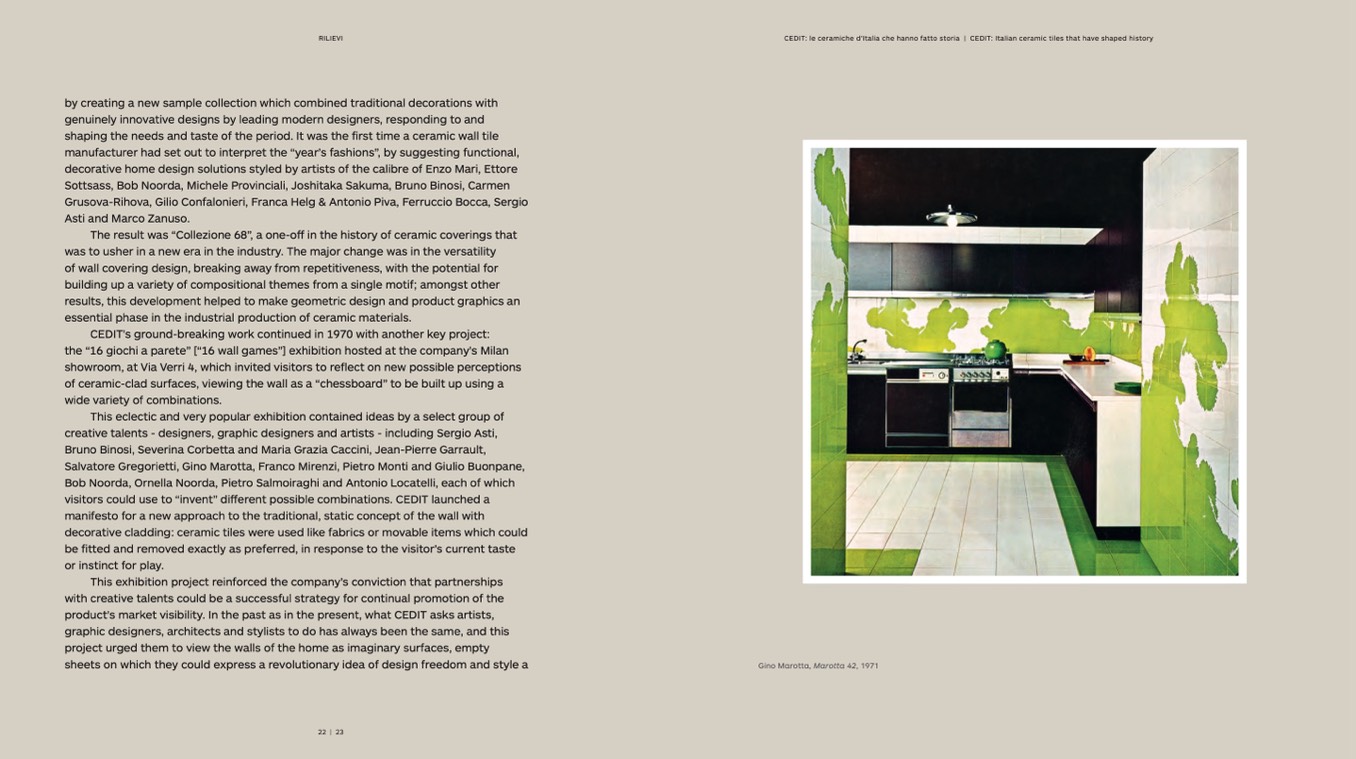
by creating a new sample collection which combined traditional decorations with
genuinely innovative designs by leading modern designers, responding to and
shaping the needs and taste of the period. It was the first time a ceramic wall tile
manufacturer had set out to interpret the “year’s fashions”, by suggesting functional,
decorative home design solutions styled by artists of the calibre of Enzo Mari, Ettore
Sottsass, Bob Noorda, Michele Provinciali, Joshitaka Sakuma, Bruno Binosi, Carmen
Grusova-Rihova, Gilio Confalonieri, Franca Helg & Antonio Piva, Ferruccio Bocca, Sergio
Asti and Marco Zanuso.
The result was “Collezione 68”, a one-off in the history of ceramic coverings that
was to usher in a new era in the industry. The major change was in the versatility
of wall covering design, breaking away from repetitiveness, with the potential for
building up a variety of compositional themes from a single motif; amongst other
results, this development helped to make geometric design and product graphics an
essential phase in the industrial production of ceramic materials.
CEDIT’s ground-breaking work continued in 1970 with another key project:
the “16 giochi a parete” [“16 wall games”] exhibition hosted at the company’s Milan
showroom, at Via Verri 4, which invited visitors to reflect on new possible perceptions
of ceramic-clad surfaces, viewing the wall as a “chessboard” to be built up using a
wide variety of combinations.
This eclectic and very popular exhibition contained ideas by a select group of
creative talents - designers, graphic designers and artists - including Sergio Asti,
Bruno Binosi, Severina Corbetta and Maria Grazia Caccini, Jean-Pierre Garrault,
Salvatore Gregorietti, Gino Marotta, Franco Mirenzi, Pietro Monti and Giulio Buonpane,
Bob Noorda, Ornella Noorda, Pietro Salmoiraghi and Antonio Locatelli, each of which
visitors could use to “invent” di
fferent possible combinations. CEDIT launched a
manifesto for a new approach to the traditional, static concept of the wall with
decorative cladding: ceramic tiles were used like fabrics or movable items which could
be fitted and removed exactly as preferred, in response to the visitor’s current taste
or instinct for play.
This exhibition project reinforced the company’s conviction that partnerships
with creative talents could be a successful strategy for continual promotion of the
product’s market visibility. In the past as in the present, what CEDIT asks artists,
graphic designers, architects and stylists to do has always been the same, and this
project urged them to view the walls of the home as imaginary surfaces, empty
sheets on which they could express a revolutionary idea of design freedom and style a
Gino Marotta, Marotta 42, 1971
RILIEVI
CEDIT: le ceramiche d’Italia che hanno fatto storia | CEDIT: Italian ceramic tiles that have shaped history
22 | 23

